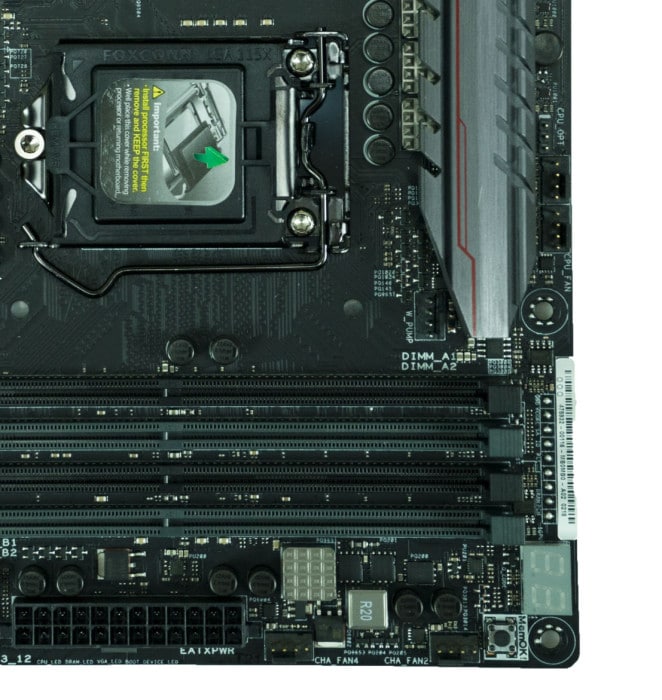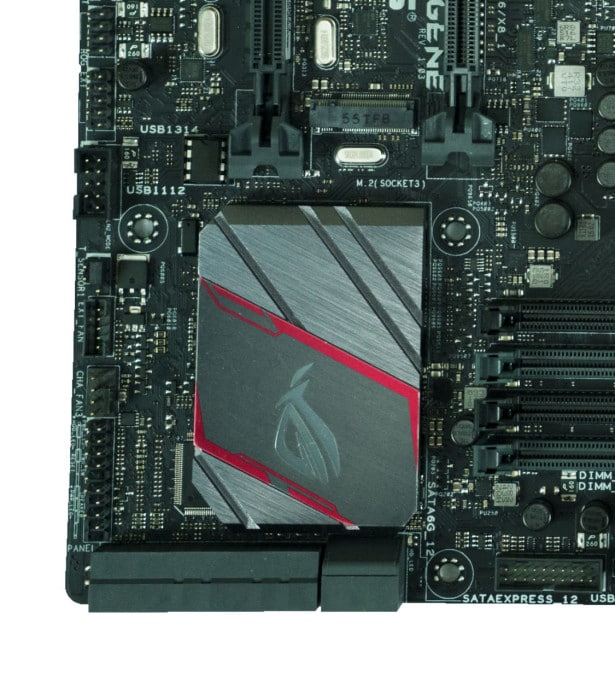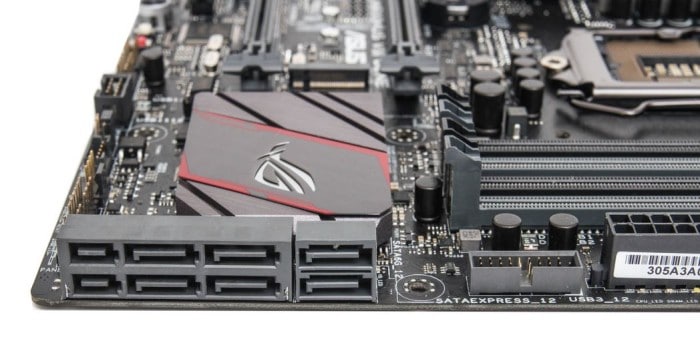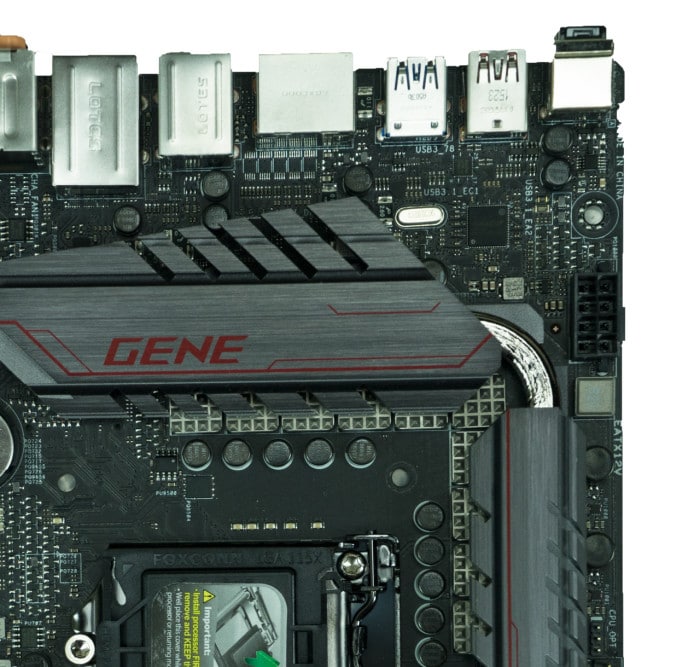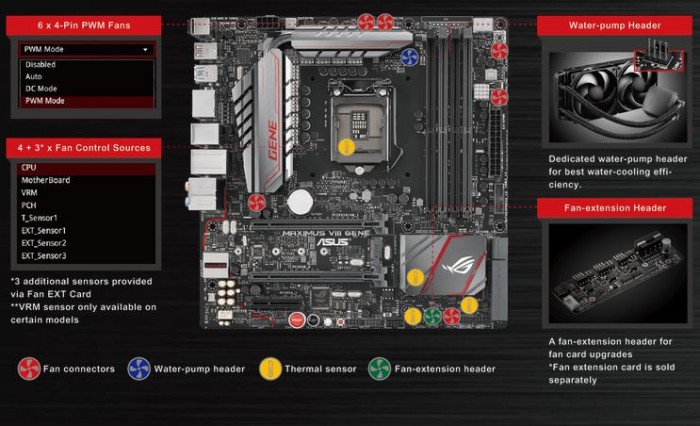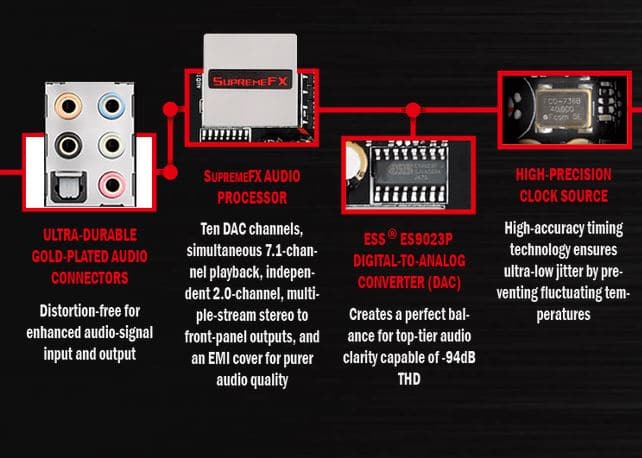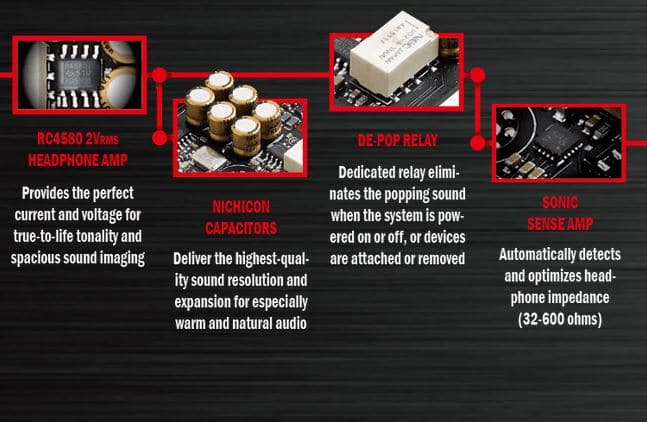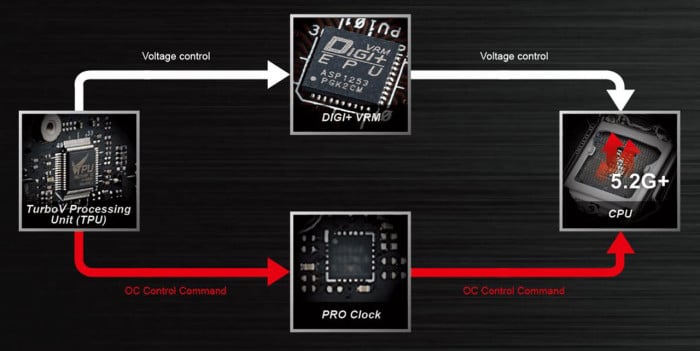Board Layout
We prefer to take an in depth closer look at the board’s features before getting too deep into description. The ASUS ROG MAXIMUS VIII GENE is based upon a black PCB that features satin black and dark red accents. In addition to this, the MAXIMUS VIII features the ominous sinister red back lighting of the SupremeFX and its audio features. When powered up the chipset heatsink glows red and the ROG logo lights up in the same sinister blood red color. At the bottom we find the start, reset, retry and safe boot buttons. All are good indications of the ROG credibility that has made the name legendary.
Taking a close look we can clearly see the 24 pin power connector and the features surrounding it. Next to this we can clearly see the post code block that is often used for debugging when it is actually needed. Then we find the mem okay button. Both memory channels utilize a single extra large power phase that is capped in a rather interesting gray diamond cover. Also clearly visible is the USB 3.0 header, two fan channels, a water pump header. While not as flashy as some of the boards we have reviewed, this particular board went with simple alternating gray and black memory slots that match the color scheme used on the board’s features.
To the left of the 24 pin power connector we get a close up view of the 6 SATA 6Gb/s ports and the two SATA Express connectors. Directly to the right of the SATA 6 Gb/s, we find the USB 3.0 header that allows up to 2 USB 3.0 ports externally. We also get a clear view of the satin black brushed heatsink with its dark red accents and clear ROG logo. The reason for the clear logo is that the red LEDs that lie underneath give the heatsink and logo a sinister red glow when the system is on.
Getting to the rear bottom quarter of the GENE board we find some of the key features. We find the M.2 with M key that as you can see allows the user to mount a wide range of compatible M.2 devices. This is flanked on both sides by the two PCIe 3.0/2.0 slots in 1 x16 or dual x8 and supports Nvidia SLi and AMD CrossfireX At the bottom we find the single PCIe 4x slot and the large red start button that is lit up and next to it are the reset, safe, and retry buttons. Then located near the rear under where graphics cards would come out the case and screw in lie the SupremeFX audio processor, SupremeFX shielding, ESS ES9023P DAC, Gold-Plated Audio connectors, Headphone AMP, high quality Nichicon Capacitors. DE-POP Relay and Sonic Sense AMP that detects and optimizes head-phone impedance. The SupremeFX shielding blocks electromagnetic interference from the board and any other components for a cleaner audio experience. The red LED lighting that traces the entire length gives off a sinister red glow.
Finally we examine the final section of this incredible board and at the beating heart of it we find the LGA1151 socket for the new 6th Gen Intel Skylake CPU’s. Flanking the socket on two sides we find the elegant but sinister satin black and dark red accent heatsinks and the silver heat pipe. Towards the end of one of the heatsinks above the memory slots we find a rather unique and special feature that is built onto this board and that is the addition of a water pump header. This feature allows the user to more closely monitor and control the speed of their water pump. On the back side of the heatsink we also find two fan headers and an 8 pin power connector. Underneath the heatsink we find 10 power phases that feature the same metallic gray studded caps. The rear, where we find the I/O ports, features electrostatic shielding and is covered by stainless steel and near this we find another fan header.
In addition to these sections we would like to cover some of the unseen but crucial features such as the myriad of thermal sensors that allow users to monitor key parts of their systems. Then there are the 6 fan headers plus the additional header for a fan expansion card that you can buy separately. These fan control headers can be controlled by several sources including the temperature sensors or several other sources that the users can directly configure to their preferences.
Board Features
The ASUS ROG MAXIMUS VIII GENE board hosts a myriad of features that make this motherboard stand out above the competition. The first distinguishing feature on this board revolves around its SupremeFX audio processor that boasts audiophile grade components and features, such features as gold-plated audio connectors to provide distortion free inputs and outputs for enhanced audio signal. Then we come to the beating heart which is their SupremeFX audio processor that has 10 DAC channels that can cover a wide range of outputs and has electromagnetic interference shielding. This is followed up be the ESS ES9032P DAC that creates the perfect balance of -94 dB. This is connected to a high precision clock source that gives high accuracy timing technology that allows for ultra low jitters through preventing fluctuating temperatures. Also built into the board is a RC4580 2VRMS Headphone AMP providing perfectly stable current and voltage for true to life tonality and sound imaging. This is followed up by Nichicon capacitor, DE-POP relay and Sonic SenseAMP that detects and optimizes headphone impedance.
This next section is focused on over-clocking performance, components like Turbo Processing Unit (TPU), Energy Processing Unit (EPU), advanced fan controls and digital power control. These features are configurable through ASUS’s critically acclaimed UEFI BIOS. The TPU allows for precise voltage control and advanced monitoring for the CPU and graphics card, allowing the user to adjust frequencies and ratios for optimized performance. Next we get to the EPU; the EPU detects and adjusts your systems power consumption according to what your computer needs in real time. The DIGI+ chip is all about controlling the power to enhance overclocking and stability to comply with Intel IMVP8 Specifications.
Also built into this board are networking features to enhance gaming. The Intel Ethernet I219-V chipset delivers smoother and faster by offering high TCP and UDP throughput, while reducing CPU overhead. This is coupled by the latest languard that provides electrostatic shielding and surge protection. Finally we get to the software side which is the third generation of GameFirst; the software allows you to prioritize game packets over non game packets while playing your favorite online game.
 Bjorn3D.com Bjorn3d.com – Satisfying Your Daily Tech Cravings Since 1996
Bjorn3D.com Bjorn3d.com – Satisfying Your Daily Tech Cravings Since 1996

